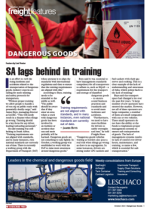There have been significant advancements in the packaging and labelling requirements for dangerous goods transported in tank containers, ushering in a new era of safety and security for the transportation of hazardous materials, according to Renée Smith, managing director of ICA Bulk Logistics. “Regulatory bodies and industry standards have been updated to ensure the proper identification, marking, and labelling of these materials, making it easier to handle and transport them safely.”In response to the critical need for safer transportation methods, regulations governing the transportation of hazardous materials have undergone extensive revisions. These changes aim to reduce risks and enhance the safety of transporting dangerous goods.“Tank containers now have advanced safety features to prevent accidents and mitigate risks. These features may include pressure and temperature sensors, emergency pressure relief valves, and f lame arrestors to minimise the risk of explosions or fires during transport,” Smith told Freight News.Industry has welcomed the move to update proper identification, marking, and labelling of hazardous materials. Tank containers must now display transparent and standardised labels that provide essential information about the contents, potential risks, and handling instructions. This not only helps transporters but also first responders in the event of an emergency.This is important considering the volume of dangerous goods moved by road in South Africa. “In most developed countries, dangerous goods are moved mainly on rail, but due to inefficient rail infrastructure, dangerous goods in South Africa are predominantly moved on the road.”Smith said the sector had several challenges it dealt with continuously. “Dangerous goods can be attractive targets for theft and misuse, especially if they have illicit purposes. Ensuring the security of shipments and preventing unauthorised access or tampering is, therefore, a critical challenge in the logistics space. This involves implementing stringent security measures, such as secure storage facilities, tamper-evident seals, tracking systems, and monitoring protocols to minimise the risk of theft, diversion, or unauthorised handling.”Operators like ICA are committed to delivering services of international standards. “We highly emphasise training, which is critically important in our industry. We also ensure that we always utilise reputable suppliers, such as depots. Agreed standards and protocols are a must.”Smith said one area where South Africa differed from its international counterparts was at terminals. “International trends are for full and partially automated terminals, with approximately 64 terminals worldwide automated while in South Africa our terminals are still very labour-intensive, which can reduce efficiency and control at certain times.”Asked about the outlook for the sector, Smith said she remained optimistic. “We are seeing an increase in customers requesting a full supply chain service. Receivers importing on a just-in-time basis request laden storage of dangerous goods cargoes and f lexible deliveries when required urgently,” she said. “Customers are looking not only for safe ways to transport and store their difficult and dangerous cargoes but need this aligned with efficient, professional and safe logistics services. This is a fascinating time to offer clients tailor-made solutions.”

